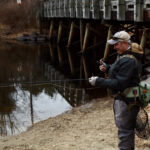It’s hard to imagine finding a fox kit or baby rabbit alone in the woods and not wanting to take it home. After all, without its mother, how will it survive?
In reality, not only is your help not needed, taking them home is the worst thing a would-be rescuer could do. A young animal is incredibly delicate as even providing the wrong type of milk can make their system shut down and kill them.
Finding a baby animal alone, people assume it has been abandoned or the mother has been killed, when in reality, she has only left temporarily to find food for either her young or herself.
“Every time this time of year, members of the public kidnap hundreds of young animals,” said David Wattles, Black Bear & Furbearer Biologist at the Massachusetts Division of Fisheries & Wildlife.
When the animals’ condition deteriorates, members of the public naturally go to Wildlife Rehabilitation Centers. These facilities are then flooded with baby animals of all species – including rabbits, deer, raccoons, foxes and fisher cats – to the point of being filled to capacity.
“(People) are trying to help but in reality it doesn’t and unfortunately it’s decreasing the chances of the animals survival,” said Wattles.
As people are increasing outdoor activities such as hiking as the weather gets warmer, they are more likely to stumble across a den, and draw the wrong conclusion, not being informed enough about wildlife to understand what is normal.
Sometimes interacting with humans can be immediately fatal for the animals despite the best of intentions, such as rabbits. “Young rabbits are fragile,” said Wattles. “Even the stress of being picked up can push them over the edge.”
They don’t need our help
Leaving young behind in a safe place is a survival strategy. Prey animals such as rabbits and deer do this rather than having the young with them to reduce risk of predation, while predators have to leave the den to hunt.
In almost all circumstances, he said, just leaving the young alone is the best option, unless it’s confirmed that the mother has been killed. “Even then it’s best to contact someone who knows what they’re doing,” said Wattles.
While thoughts of “Bambi” and other Disney movies can play a role in the rescuer mentality, Wattles is more inclined to cite reality television as a primary factor. “A lot of shows these days like ‘North Woods Law’ have really highlighted wildlife rehab,” he said. Raising awareness is fine but these television shows have normalized it to an extent that every animal they meet needs saving.
“People still have the idea that it’s a zoo out there and these are domesticated animals that need our help,” said Wattles.
What to do if an animal makes a den under your porch
Even without accidental kidnapping, attempts to help animal neighbors can do more harm than good, Wattles cautioned. Discovering a den of foxes under the porch or shed, people need to resist the temptation to feed them or leave out food, which can lead to habituation and harm to the animals down the line.
It’s important to remember that whatever the animal, they won’t be there for long. In the case of foxes and coyotes, it will be about eight to 12 weeks before they are old enough to leave the den, after which they will range through the territory and are unlikely to return.
This roughly translates to around the end of May to the first half of June when the majority of pups are starting to leave the den, said Wattles, for some it may be earlier.
If for whatever reason you’re not comfortable with your four legged tenants, it’s a simple matter to get them to move the den and their pups. Wattles recommends leaving a radio talk show playing – or a podcast, kicking dirt into the den, or leaving some rags dipped in ammonia (but not bleach, that’s too caustic) nearby.
How do I know if an animal has rabies?
Unsteadiness, disorientation, and being either lethargic or manic are all symptoms of rabies. “Any animal that is hyper aggressive is a strong indicator,” said Wattles.
However, the symptoms can be similar to distemper, of which there has been a high incidence, especially around the Connecticut River Valley, seen in raccoons and skunks.
“Simply being out during the day, even for a nocturnal animal, does not mean it’s rabid,” he emphasized.
Though if bitten or scratched by a mammal, seek medical attention to begin rabies treatment, regardless if you think it’s rabid or not, he said, and is yet another reason not to handle young animals – to avoid diseases that jump between species.












